
* The Blackburn Buccaneer was designed in the mid-1950s as a low-level carrier-based maritime strike aircraft. It proved far more long-lived than its designers ever intended, serving with distinction not only with the British Royal Navy's Fleet Air Arm (FAA) but with the Royal Air Force (RAF) for decades, and as a finale demonstrating its effectiveness in the Gulf War. This document provides a history and description of the Buccaneer.
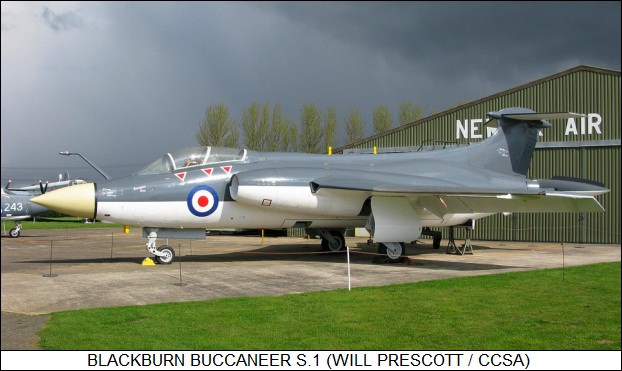
* During the early 1950s, the Soviet Navy underwent a major fleet expansion to challenge Western naval supremacy, creating a serious threat with their new SVERDLOV-class cruisers. In response, the British Royal Navy decided to obtain a low-level carrier based attack aircraft. This aircraft was intended to penetrate the defenses of Soviet naval battle groups by streaking in at low level and high speed, then obliterating them with a nuclear weapon using a "toss-bombing" attack.
The requirement was formalized as "Naval Staff Requirement Number 39 (NA.39)" in June 1952, which called for a two-seat carrier-based aircraft that could carry a nuclear weapon internally, fly at a speed of Mach 0.85 at an altitude of 60 meters (200 feet), and operate over a combat radius of at least 740 kilometers (460 miles). It was to have an offensive radar system and a radar altimeter. Total weapons load was to be 1.8 tonnes (4,000 pounds); the length could be no more than 15.5 meters (51 feet) in stowed configuration to allow accommodation on existing carrier-deck elevators; and the maximum weight was to be no more than 20.4 tonnes (45,000 pounds). The aircraft was also to be able to act as a tanker.
* Most of the major British aircraft manufacturers submitted proposals for the requirement, with the proposals whittled down to three finalists: the Armstrong-Whitworth "AW.168", the Shorts "PD.13", and the Blackburn "B.103".
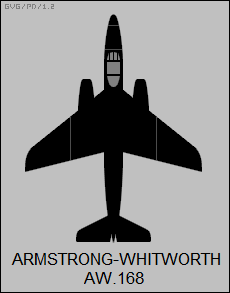
The Armstrong-Whitworth AW.168 was a conservative design, with a conventional layout, moderately swept wings, and twin Bristol Siddeley "Gyron Junior" turbojet engines, mounted in nacelles attached to the bottom of the wings. It was to feature leading edge slats and a "boundary layer control (BLC)" or "blown flaps" scheme, in which engine bleed air was vented over the top of the flaps to reduce the stall speed. An exhaust deflector scoop was to be fitted behind each engine to direct thrust down at an angle of 45 degrees, permitting short take-offs. The aircrew sat side-by-side under a bubble-type canopy, and the wings folded up just outboard of the engines.
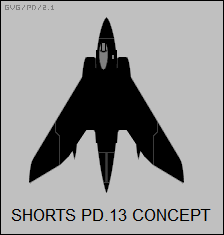
The Shorts PD.13 was a very unconventional design, a tailless aircraft featuring a highly swept "aero-isoclinic" wing -- a concept developed by Geoffrey Hills of Shorts -- in which the wingtips pivoted up and down to provide flight control. It was to be powered by twin Rolls-Royce Avon RA.19 turbojets, with exhausts that could be deflected downwards. An offset fighter-style cockpit was fitted on the left side of the nose for the pilot, while the navigator sat in a "coal hole" compartment under a hatch on the right side of the nose. There was a teardrop fairing on the rear of each wing, used to store the backward-retracting main landing gear assemblies. The PD.13 might have looked bizarre, but Shorts had flown an aero-isoclinic wing demonstrator, the "SB.4", and it had been very pleasant to fly.
At the time, Blackburn was building nothing more warlike than transport and cargo aircraft, but the company's B.103 design seemed impressive. The B.103 featured twin engines; Blackburn originally considered the Armstrong Siddeley Sapphire Sa.7 turbojet, only to find it too bulky and heavy, and the Gyron Junior engine was selected instead. The flight surfaces were moderately swept, with the tailplane mounted high on the tailfin in a "tee" configuration. Since smooth low-level flight dictates small wings, while small wings mean a "hot" landing speed, Blackburn engineers designed a BLC system, with 10% of engine compressor airflow blown not only over the flaps, but also over the tee tail -- the scheme providing de-icing as a plus.
The B.103 incorporated the new "area rule" aerodynamics, where abrupt changes in the cross-sectional area of the aircraft were avoided to improve high-speed handling. Area ruling means that the fuselage shrinks where the cross-section includes the wings, and then expands again after the wings, giving the fuselage a graceful "wasp waist" or "coke bottle" appearance. Blackburn engineers used area-ruling to improve the design's aerodynamics, while also increasing the storage capacity of the aircraft's fuselage, giving the aircraft a distinctive set of full-bodied curves.
The aircraft met the carrier-deck elevator dimension limits through a number of features. Its wings folded up through 120 degrees from a hinge at half-span, and its nose cone could be pivoted back to allow access to its radar and reduce length. The tail cone was split and could be hydraulically opened to the sides to act as a variable air brake, as well as reduce length. All these features allowed the B.103 to fit neatly on an elevator and in the hangar deck.
The B.103 was designed to be fitted with two stores pylons under each wing, for a total of four, and also had a bomb bay, which was to accommodate four 450-kilogram (1,000-pound) bombs or a single nuclear weapon. A conventional bomb bay was not regarded as suitable for high-speed low-level attack, and so the B.103 was given a rotating bomb bay door, with munitions attached to the door itself. The door could snap around rapidly, reducing aerodynamic interference. The rotating bomb bay not only simplified weapons release, but made it easier to load munitions and perform servicing. Other stores, such as a reconnaissance camera pallet, were also planned to be carried in the bomb bay.
* The design was frozen by the summer of 1954. In July 1955, the British Admiralty selected the B.103 from the three finalists, on something of a "Goldilocks" line of reasoning. The Armstrong-Whitworth AW.168 was too cold; it would present the least risk and get into service the fastest, but it would also soon be obsolete. The Shorts PD.13 was too hot: it was the most advanced of the designs, but the risk level was high. The Blackburn B.103 was just right, neither too stodgy nor too daring. The contract placed an order for 20 "development batch (DB)" aircraft. That was an unusually high number of pre-production aircraft, but the Royal Navy was in a hurry and wanted to ensure that loss of a prototype would not delay the program. The service also wanted to pursue development of various subsystems in parallel.
Development work on the B.103 proceeded in deep secrecy. The Admiralty requested that a prototype be flying by April 1958, and the first prototype managed to take to the air on 30 April. Successive prototype production gradually incorporated features for operational aircraft. Carrier trials began in early 1960, having been delayed several months by the stall and crash of one of the prototypes, with both crew members killed after ejecting from their inverted aircraft.
On 20 August 1960, the new aircraft was given its official name: "Buccaneer". The initial version was designated "Strike Mark 1 (S.1)". All 20 DB aircraft had flown by the end of 1961, though there were further losses. One went down in October 1960 due to a flight instrumentation failure, the two crewmen ejecting safely. Another was lost in August 1961 on take-off during carrier trials, both crewmen drowning because they were unable to escape from the aircraft.
Despite the calamities, the flight test program otherwise went well, and the first Buccaneers were delivered to the Royal Navy in August 1961. Number 801 squadron became the first operational Buccaneer unit in July 1962, with operational cruises beginning in 1963. Ground-based Buccaneers operated out of a number of naval air stations, but the Buccaneer would be particularly associated with the naval air station at Lossiemouth, on the northeast coast of Scotland. The 20 DB aircraft were originally all retained by Blackburn for development and trials, but some were eventually brought up to service fit and handed over to the Royal Navy.
BACK_TO_TOP* The production Buccaneer S.1 embodied the design outlined for the B.103: two non-afterburning Gyron Junior Mark 101 turbojets providing 35.6 kN (3,630 kgp / 8,000 lbf) thrust each, one mounted in a nacelle with a circular intake on each side of the fuselage; mid-mounted swept folding wings of relatively modest area, with a boundary layer control or "supercirculation" system; a high tee tail; an area ruled fuselage; a folding nose cone; a split tailcone / air brake; and four stores pylons, plus the rotating bomb bay door. The airframe was designed with an emphasis on strength, and the aircraft would generally be described as being "built like a brick outhouse".
The wing sweep was 40 degrees at the root; 38 degrees 36 seconds in midspan; and 30 degrees 12 seconds for the outer span. The wing was set at an incidence angle of 2 degrees 30 seconds. Each wing featured a flap on the inboard (non-folding) section, and an aileron on the outboard (folding) section. The flaps had four positions, the maximum being 45 degrees. There was a somewhat complicated arrangement of ductwork in the wing for the BLC system, with a duct running behind the front of the wing to provide bleed air out the leading edge and another duct on the rear of the wing to provide bleed air over the flaps and ailerons. How the ductwork handled the wing folding is an interesting minor mechanical question.
There was a row of small "vortex generator" vanes towards the front of the outboard section of the wing to prevent airflow separation. The original B.103 design had featured twin flaps on each wing and a leading-edge slat, but the BLC system rendered them unnecessary. The high-mounted tailplane was all-moving; what appeared to be elevators were actually flaps, used in conjunction with bleed air from the BLC system driven out the tailplane. BLC ductwork ran up the tailfin and along the leading edges of the tailplane. The tailfin itself had a conventional rudder.
The S.1 was equipped with tricycle landing gear, with all gear assemblies featuring single wheels. The nose gear retracted backwards, while the main gear hinged in the wings just outside the engine nacelles and retracted in towards the fuselage. The nose wheel was steerable, capable of being pivoted 50 degrees off the centerline, and the landing gear featured an antiskid braking system. There was a small extendable bumper wheel on the rear fuselage to prevent damage to the tail on steep take-offs, and a stinger-type arresting hook on the end.
Total internal fuel capacity was 7,092 liters (1,871 US gallons) in eight tanks in the upper fuselage. There were no fuel tanks in the wings. The internal fuel load could be augmented by two underwing "slipper" tanks, mounted around the inboard stores pylons against the wing, a configuration that minimized drag. Each slipper tank had a capacity of 1,136 liters (300 US gallons). A 2,000-liter (528 US gallon) ferry tank could also be plugged into the bomb bay; range was not a problem with the Buccaneer. Initial prototypes had a retractable refueling probe, but it didn't work out well in trials, and a bolt-on removeable offset probe was quickly designed in its place. The bolt-on probe was slightly offset to the right, and was marked to act as a crude bomb-aiming system as a validation check for the aircraft's formal bombing system.
Although it seems a bit odd to American sensibilities, the catapult attachment was not on the nosewheel. There were attachments for a "bridle" cable under each engine nacelle, and when ready for a carrier take-off the aircraft was strapped with the bridle so that the nosewheel was in the air. This scheme was awkward in appearance, but it was reliably used with other Royal Navy jets and gave an aircraft a high angle of attack on take-off to help it get off the deck.
* The pilot and navigator sat in tandem, each on a Martin Baker ejection seat. The original seat fit appears to have been the Mark 4MS, which had a zero altitude capability but required a minimum flight speed for safe operation. The two seats were offset about 5 centimeters (2 inches) from the centerline, in opposite directions, and the rear seat was raised slightly. This gave the navigator in the back seat a better forward view. The two crew sat under a single bubble-type canopy that provided fairly good all-round vision and opened by sliding to the rear. There was a transparent blast screen between the two seats to protect the navigator when the pilot ejected or if the windscreen were shattered. However, the windscreen was very tough, being a laminate 6.35 centimeters (2.5 inches) thick and proof against birdstrikes.
Avionics was state-of-the-art for the time, including UHF radios and an IFF (identification friend or foe) transponder, as well as an analog flight computer; a gyrocompass flight reference system; a radar altimeter, very important for low-level strike; and an Elliot autopilot. There was a strike camera in a blister under the nose -- though it seems that later in the Buccaneer's career the camera wasn't actually fitted.
Combat operations were supported by the Ferranti Blue Parrot (AIRPASS III) radar in the nose, which provided search and mapping functions, as well as semi-automatic toss bombing of a nuclear store. Once the aircrew established a target lock, the Blue Parrot would generate a steering signal for the pilot to keep him on target and tell him when to pull up for the bomb toss. The bomb would be automatically released at the proper time, with an audio tone cutting off at release to cue the pilot to turn around and get out of the blast area as fast as possible.
The Blue Parrot did not have terrain-following capabilities, which would have been very handy for the low-level strike role. All later Buccaneer variants would retain the Blue Parrot radar. The only defensive countermeasures system was a simple broadband radar warning receiver (RWR), with the antennas in what looked like a little rocket tip sticking out of the middle of the leading edge of each outer wing panel. Since not all pictures of the S.1 show these little fairings, it seems they may have been removeable.
* The Buccaneer had been designed specifically as a maritime nuclear strike aircraft. Its intended store was a guided nuclear gliding bomb with the odd named of "Green Cheese", but this weapon was canceled, and in its place the designated nuclear store was the unguided 900-kilogram (2,000-pound) "Red Beard", which had been developed for the Canberra. Red Beard had an explosive yield in the 10 to 20 kiloton range. It was mounted on a special bomb bay door into which it nested neatly to reduce aerodynamic buffet on the launch aircraft. Red Beard was an unsophisticated weapon and had to be armed before take-off instead of in flight, clearly an undesireable feature.
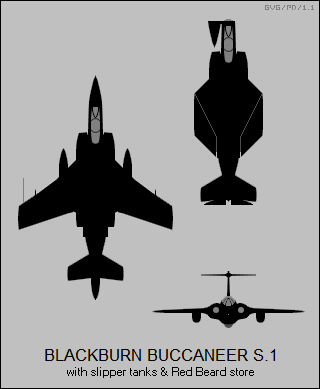
The Buccaneer S.1 could carry an alternative conventional warload of up to eight 450-kilogram (1,000-pound) bombs, with four in the bomb bay and one on each of its four underwing pylons, though six total was a more typical fit. The S.1 could also carry unguided rocket packs on its underwing pylons. The Buccaneer originally used 50-millimeter (2-inch) rockets in 36-round packs, but this weapon was later phased out in preference to the 68-millimeter (2.7-inch) Brandt / SNEB rocket in 18 round packs. The Buccaneer was evaluated with the US-built AGM-12 Bullpup radio-guided air-to-surface missile in 1965. However, the Bullpup proved an unreliable and inaccurate weapon, and was rarely carried in practice. The Buccaneer could be operated as a tanker, carrying a Flight Refueling LTD M20 probe-and-drogue refueling pack with a capacity of 636 liters (168 US gallons) under the right wing, augmented by a slipper tank under the left wing.
As mentioned, the bomb bay could also accommodate a 2,000-liter ferry tank, as well as a photo-reconnaissance "crate" or a cargo container. The reconnaissance crate could accommodate a photoflash flare dispenser and up to six cameras, in various configurations of long range, wide angle, and night vision cameras that could be mounted in vertical, oblique, or (using a blister in the pack) forward-looking orientations. The photoflash unit was rarely used, with the Royal Navy preferring to use the Gloworm rocket, with eight mounted on the Buccaneer's stores pylons, for night operations. The cargo container would prove useful for transporting golf clubs and other essentials. There had been plans to develop a bomb bay tanker pack, but the underwing pack proved adequate. There was also a plan for a pack with twin Aden 30-millimeter cannon, but it was abandoned and the Buccaneer would never carry gun armament.
* Two Royal Navy Fleet Air Arm operational squadrons and a training unit were equipped with the Buccaneer S.1. Navy aircrew liked the aircraft. It was strong, handled well, provided a marvelous smooth and solid ride down on the deck, and the BLC system gave them slower landing speeds than they were accustomed to.
Early in development, the B.103 had been assigned the designation "ARNA", for "A Royal Navy Aircraft". This acronym became reinterpreted as "Banana", and the Buccaneer would from then on be nicknamed "Banana Jet". The press liked to call it the "Brick", to the annoyance of Buccaneer crews. Some early S.1s were painted in overall white to resist the flash of a nuclear explosion, with these machines sometimes called "peeled bananas", but S.1s typically were painted dark sea gray on top and white on the bottom.
The Buccaneer S.1 was a very good aircraft, but the Gyron Junior engines were not powerful enough, particularly with ten percent of the airflow drained off for the BLC system. The lack of power meant that the Buccaneer could not take off with a full fuel load; to obtain good range, the Buccaneer S.1 had to be launched with a partial fuel load and then refuel from a Supermarine Scimitar fighter configured as a tanker. Only 40 S.1s were built, and by the end of the 1960s, the survivors had been relegated to training status.
The career of the Buccaneer S.1 came to an abrupt end in December 1970. On 1 December, an S.1 was making a landing approach when an engine surge disrupted the approach and forced the two crewmen to eject. On 8 December, an S.1 on a training flight suffered a turbine failure. The pilot successfully ejected, but due to a mechanical glitch, the back-seater was killed. Inspections showed that the Gyron Junior engines were no longer suited for operations. All surviving S.1s were grounded immediately and for good.
BACK_TO_TOP* Even before the S.1 reached operational status, the Royal Navy was investigating a Buccaneer with better engines, to be designated "S.2". In January 1962 the Admiralty ordered an updated version of the Buccaneer with new Rolls-Royce Spey bypass turbojets. The non-afterburning Spey variant selected provided 50.6 kN (5,160 kgp / 11,380 lbf) thrust, much more than the Gyron Junior, and had better fuel economy.
Interestingly, the Speys were about the same size as the Gyron Junior, and so only a few modifications were required to fit the new engines. The most visible of them were the distinctive large elliptical air intakes, introduced because the new engines required greater airflow. The exhaust jetpipes were changed to toe outward and downward, and angled wingtips were added to improve cruising range. The BLC system was enhanced to take advantage of the greater airflow, further reducing the Buccaneer's take-off and landing speeds, and a new electrical system was fitted. To deal with aircraft escape, miniature detonating cord (MDC) was tacked onto the canopy to shatter it for emergency exit.
Two of the initial developmental aircraft were converted to Spey power, and the first Spey-powered Buccaneer flew on 17 May 1963. The flight test program went more smoothly than that of the S.1, with no aircraft lost in accidents. Three of the test aircraft flew to the US in the summer of 1965 to perform hot weather and carrier trials on the USS LEXINGTON. One of these aircraft flew back across the Atlantic unrefueled, a dramatic demonstration of the Buccaneer's outstanding range.
The S.2 entered FAA operational service with Number 801 Squadron in October 1965. By that time, it was becoming increasingly apparent that the days of the Royal Navy's big carriers were numbered. That meant an uncertain future for the Buccaneer, but for the moment FAA pilots were pleased with the greater power provided by the machine. Early on, S.2s retained the dark gray top and white belly paint scheme of the S.1, but soon were painted in an overall dark gray scheme. There were experiments with schemes featuring a dark gray top and light gray bottom, or overall light gray, but they were not adopted for service use.
* The service introduction of the S.2 was marred by two crashes. One plowed into the sea in June 1966 after catapult take-off; the accident was blamed on pilot error, until a test pilot investigating the matter crashed himself under the same circumstances in October 1966. As it turned out, the Buccaneer was prone to a certain amount of instability after catapult launch. The problem was addressed with some minor aerodynamic and procedural changes, but the Buccaneer still required careful pilot attention under certain launch conditions.
The Buccaneer S.2 conducted several carrier tours during 1966 and 1967, ironically as the Royal Navy's big carriers were on the way out. In late March 1967, the Buccaneers performed their only sinking of a large ship when they attacked the abandoned oil tanker TORREY CANYON, grounded near Land's End in Cornwall, hitting the vessel with 450-kilogram (1,000-pound) bombs. In another irony, the objective hadn't been to sink the tanker but to set its cargo on fire, with help from Hunters and Sea Vixens carrying incendiaries.
In the meantime, the Royal Navy was updating its Buccaneers. They were refitted with Martin Baker Mark 6MSB ejection seats beginning in 1968, with the new seats providing a true "zero-zero (zero speed / zero altitude)" ejection capability. More significantly, the S.2s were modified to carry the Martel precision-guided missile. The Martel was available in anti-radar (AS.37) and television-guided (AJ.168) versions; it was seen as such a significant enhancement that modifying the Buccaneer to carry it was worthwhile, even if there were uncertainties about the future of the aircraft.
The Martel update was formally initiated in September 1966, with the Buccaneers modified to carry four Martels, one on each pylon. Larger pylons were fitted to accommodate the missile, with the side benefit of allowing three 450-kilogram (1,000-pound) bombs to be carried on each pylon using a triple-ejector rack. However, the triple-ejector rack would never be used in practice, though a double-ejector rack was used on occasion to carry two 225-kilogram (500-pound) bombs.
Some strengthening and structural changes were also performed, and the back-seater's station was modified to fit in the television display and joystick controller needed for the AJ.168 Martel. Communications with the AJ-168 were performed though a spindle-shaped datalink pod mounted on one of the stores pylons. While a Buccaneer could carry four anti-radar Martels, the requirement for the pod meant that the aircraft could carry no more than three television-guided Martels. A common fit was a datalink pod, two TV-guided Martels, and one anti-radar Martel. A training pod could be carried in place of the datalink pod; it looked like a datalink pod with a Martel TV seeker on the nose, and could be used to acquire and track a target.
The Martel update program was protracted, with the first Martel-capable Buccaneers delivered to the Royal Navy at the somewhat late date of October 1972. At that time, the Buccaneer was expected to be out of service with the FAA by mid-decade, though this schedule would slip a bit. The last Royal Navy Buccaneers were actually phased out in December 1978.
BACK_TO_TOP* Early in the Buccaneer program, the US Navy had expressed mild interest in the aircraft, but quickly moved on to the development of their comparable Grumman A-6 Intruder. The West German Navy showed a greater interest and considered replacing their old Hawker Sea Hawks with the type, though they would eventually decide on the Lockheed F-104G for their maritime strike requirement. The only export customer for the Buccaneer proved to be the South African Air Force (SAAF).
In January 1963, even before the S.2 entered squadron service, South Africa had purchased 16 Spey-powered Buccaneers. The aircraft order was part of the "Simonstown Agreement", in which the UK obtained use of the Simonstown naval base in South Africa in exchange for maritime weapons. The SAAF wanted to use the Buccaneer for antiship strike.
The South African Buccaneers were given the designation of "S.50". They were similar to the S.2, with various modifications. Some of the equipment for carrier-deck operations was deleted, such as the hydraulic gear needed to automatically fold the wings, though the wings could still be folded manually. The S.50 also had larger underwing tanks with a capacity of 1,955 liters (516 US gallons); featured two small and distinctive strakes under the rear fuselage; and was fitted with two Bristol Siddeley BS-605 retractable booster rockets. The rockets were intended to assist take-offs when operating from airstrips at high altitude in hot weather. They were powered by the Buccaneer's jet fuel and flasks of high-test peroxide oxidizer. They produced 1,810 kilograms (4,000 pounds) thrust for 30 seconds. Despite the expense of adding this feature, it was rarely used for anything but airshow fireworks.
The first Buccaneer S.50 flew in early 1965. The 16 aircraft were delivered in two sets of eight, with one Buccaneer lost in the South Atlantic during delivery. The South Africans wanted to buy a replacement, but activism against South African apartheid policies was on the increase and the new British Labour government denied the request. SAAF plans to obtain 14 more Buccaneers fell through.
The SAAF Buccaneers served for decades, providing a useful service in a range of roles. Their standard color scheme was dark gray on top and dark blue on the bottom, with some variation in pattern over time. In the maritime strike role, SAAF Buccaneers were armed with the French radio-guided AS-30 missile. However, in 1971 Buccaneers fired 12 AS-30s at an abandoned tanker, the WAFRA, that had become a menace to navigation and failed to sink it, the vessel finally being finished off by depth-charge attacks from a Shackleton patrol aircraft. Clearly, the AS-30 left something to be desired as an antiship weapon.
For overland attack, the SAAF Buccaneers carried up to four 450-kilogram (1,000-pound) bombs in the rotary bomb bay, and four bombs, flares, or SNEB rocket packs on the underwing stores pylons. The AS-30 was used in ground attacks for effective precision strikes on radar sites and other targets. The Buccaneers saw extensive action over Angola and Namibia in the 1970s and 1980s, and attacked SWAPO insurgent camps with rockets and bombs.
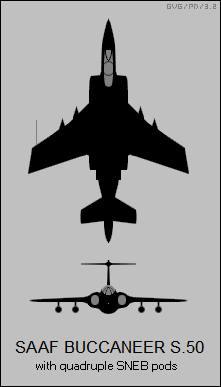
SAAF Buccaneers were also fitted with a locally-designed reconnaissance pack or the M20 buddy tanker pack. In the mid-1970s, the SAAF Buccaneers were modified to accommodate a large bomb bay fuel tank for ferry flights or tanker operations. The last SAAF Buccaneer S.50s were retired from service in 1991. By this time, only five of the original 15 delivered were still in flying condition.
BACK_TO_TOP* Even before the Buccaneer entered service with the Royal Navy, Blackburn had been trying to interest the British Royal Air Force (RAF) in the type, but the RAF wanted to obtain a much more sophisticated low-level strike aircraft, the BAC TSR.2. The TSR.2 had Mach 2 performance, and the subsonic Buccaneer looked old-fashioned in comparison. The RAF refused to give the Blackburn proposal any attention, since the service feared the TSR.2 would be canceled if they did.
The TSR.2 was canceled anyway in 1965 in a great controversy that still faintly rumbles on. Hawker Siddeley, which had merged with Blackburn in 1963 and obtained the Buccaneer along with it, proposed a Buccaneer variant designated the "P.145" or "S.3" to fill the RAF requirement. This machine featured the rocket boosters of the South African S.50 variant, plus main gear assemblies with four-wheel bogies for rough field operation; larger underwing tanks; state-of-the-art navigation-attack system and radar; and carriage of advanced weapons, such as the Martel. The RAF was much more interested in the US General Dynamics F-111K, and for the moment had no real interest in the Buccaneer.
The F-111K was canceled in turn in early 1968 after the program suffered serious cost escalation and schedule stretchout. The RAF was forced to cast about for a replacement that was available and affordable, and reluctantly settled on the Buccaneer. In July 1968, with a irony lost on no one, the RAF wearily ordered 26 modified Buccaneer S.2s. These new-build aircraft were to be fitted for the Martel missile and partly denavalized. They were not capable of carrier operations; although they had arresting hook and folding wings, they did not have catapult attachments.
RAF S.2s were also fitted with an instrument landing system (ILS) receiver, marked by two little antennas mounted forward on the tailfin like a miniature second tailplane. The ILS fit remains a little mysterious -- the antennas were distinctive, but don't seem to be apparent on all pictures of RAF Buccaneers, implying that ILS was added later. No pictures of FAA Buccaneers show the ILS antennas, but to confuse matters further some pictures seem to show little mountings where the antennas should be, as if there were provision for them, but they weren't fitted.
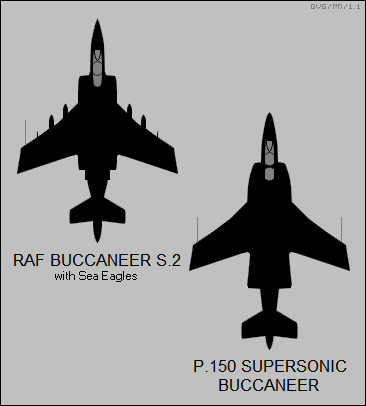
Hawker Siddeley did try to sell a supersonic version of the Buccaneer designated the "P.150" to the RAF. The P.150 featured the four-wheel main gear bogies of the P.145; a stretched fuselage, with twin afterburning Spey engines; a modified cockpit, with separate canopies for the front and back seaters; and generally updated combat avionics and weapons capability. However, Britain was then moving forward on an international collaboration that would ultimately produce the Anglo-German-Italian Panavia Tornado strike aircraft. The Buccaneer was seen simply as an interim solution, and there was no reason to want frills. Delays in the Tornado program would ensure that the "interim" period would stretch out, and the Buccaneer would remain in RAF service for over two decades, long after the FAA had given up on it.
* The first RAF Buccaneer was delivered in early 1969, and the first operational RAF Buccaneer squadron, Number 12, was formed that year as well. This initial squadron operated out of the UK for maritime strike. Later RAF Buccaneer squadrons were intended for low-level tactical strike and operated mostly in Germany. Tactical strike aircraft were not fitted with refueling probes, since mid-air refueling was not deemed necessary in the Central European operating environment. They were initially given a paint scheme with a dark gray and dark green disruptive pattern on top and a light gray belly, but eventually these aircraft were painted in dark gray and dark green patterning overall.
Although the RAF had spent a decade snubbing the Buccaneer, once they got their hands on it, they appreciated just what an outstanding combat aircraft it really was. The RAF inherited 64 more Buccaneer S.2s from the FAA as the Royal Navy's carrier force was drawn down, with these aircraft given some minor tweaks to adapt them to RAF service, and even bought 19 more new-build Buccaneers. The last Buccaneer built was delivered in October 1977. British Buccaneer strength was at its highest point in 1978, when five RAF and FAA operational squadrons flew the type.
In 1972, the Buccaneer S.2 was assigned a somewhat confusing series of subvariant designations:
Major updates of the Buccaneer were considered during its history, but nothing more sophisticated than the S.2 ever flew. However, some changes were made to keep the Buccaneer up to date. One significant modification was an auxiliary tank with a capacity of 1,932 liters (510 US gallons) built into a visibly bulged bomb bay door. This modification was required because aerodynamic difficulties kept the RAF S.2s from using the enlarged South African slipper tanks. A Buccaneer fitted with the new bomb bay door fuel tank first flew in 1970, and the tank was retrofitted to most operational S.2s. With both slipper tanks and the big bomb bay tank, an S.2 had a ferry range of 4,257 kilometers (2,645 MI / 2,300 NMI) -- the equivalent of a jaunt from San Francisco to Hawaii, meaning it could effectively self-deploy to anywhere in the world with ground fuel stops.
New weapons were introduced. The Red Beard nuclear weapon was phased out in 1970, replaced by the WE-177A, a parachute-retarded 270-kilogram (600-pound) bomb that was made in several yield options, including 10, 190, and 450 kilotonnes of TNT. Buccaneers were eventually qualified to carry two WE-177As. The SNEB rocket pack was replaced by the highly effective Hunting BL-755 cluster bomb unit, with the last SNEB mission flown in 1973.
On occasion, Buccaneers would also carry a single AIM-9B Sidewinder missile, but early Sidewinders were not very effective, and the AIM-9B provided little useful self-defense capability. Buccaneer pilots had another self-defense option, however: they could drop a 450-kilogram (1,000-pound) parachute-retarded bomb while operating at low level over water to discourage a fighter pressing them from the rear. This practice was known as "retard defense", or more informally as "dropping your knickers".
The final batch of new production Buccaneers for the RAF featured an ARI 18228 RWR in the tailplane bullet fairing, with this enhancement retrofitted to earlier aircraft. The ARI 18228 was more sophisticated than the original broadband RWR carried in the wing leading edge bullet fairings, providing a directional display in the cockpit. The American Westinghouse AN/ALQ-101(V)-10 active electronic countermeasures pod was supplied to Buccaneer units from 1976 as a self-defense measure. The Buccaneer was the first operational RAF aircraft to carry an external jammer pod. The Northrop AN/AAQ-8 infrared countermeasures pod was also evaluated, but not adopted. Minor modifications were made to the Blue Parrot radar system as well.
In 1979, the RAF obtained the American AN/AVQ-23E Pave Spike laser target designator pod. The Pave Spike carried a television camera boresighted with a laser beam, with the optics protected by a retractable nose shield. The Pave Spike was carried by Martel-capable Buccaneers, which had the back-seater TV display and joystick controller needed to make use of the pod. The Pave Spike was wired in through the left inboard stores pylon. Buccaneers carrying Pave Spike were capable of guiding laser-guided bombs for sibling Buccaneers, Jaguars, and other strike aircraft.
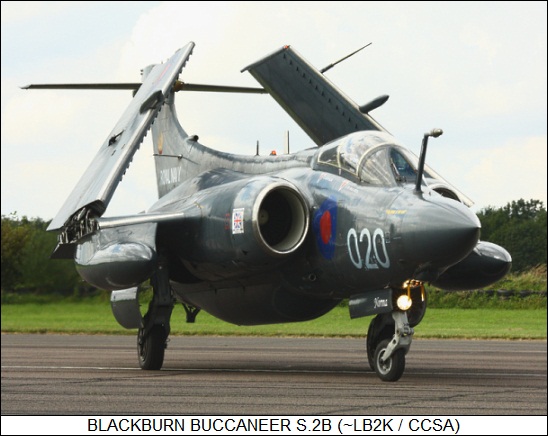
The RAF inherited some reconnaissance crates along with their FAA Buccaneers, but RAF Buccaneers rarely, if ever, flew reconnaissance missions. Buccaneer crew on maritime patrol were sometimes provided with hand-held cameras to photograph Warsaw Pact vessels.
___________________________________________________________________
BUCCANEER S.2B:
___________________________________________________________________
wingspan:
13.4 meters (44 feet)
wing area:
47.82 sq_meters (514.7 sq_feet)
length:
19.3 meters (63 feet 5 inches)
height:
4.95 meters (16 feet 3 inches)
empty weight:
13.6 tonnes (30,000 pounds)
max loaded weight:
28.1 tonnes (62,000 pounds)
maximum speed:
1,000 KPH (620 MPH / 540 KT)
service ceiling:
12,200 meters (40,000 feet)
typical range:
3,700 kilometers (2,300 MI / 2,000 NMI)
___________________________________________________________________
* Opportunities for Buccaneer squadrons to engage in realistic training were limited, and so when the US began their Red Flag yearly military exercises at Nellis Air Force Base in Nevada in 1975, the RAF became keenly interested. The first Red Flag in which RAF aircraft were involved was in 1977, with ten Buccaneers and two Vulcan bombers participating.
Buccaneers would be involved in later Red Flags through 1983, and in 1979 also participated in the similar Maple Flag exercise over Canada. The Buccaneer proved extremely impressive with its fast low-level attacks, which were highly accurate despite the aircraft's lack of terrain-following radar and other modern avionics. However, during the 1980 Red Flag exercises one of the Buccaneers lost a wing and crashed, killing its crew. The cause of the accident was fatigue in the front wing spar, and the entire Buccaneer force was grounded and inspected. Some were repaired while others were condemned and scrapped, and due to this attrition one Buccaneer squadron was disbanded. About 50 or 60 S.2s survived from a pre-accident RAF total of 90 machines.
In the early 1980s, the Panavia Tornado IDS began to replace the Buccaneer in the overland strike role, and the Buccaneer was increasingly reassigned to maritime strike, retaining overland attack as a secondary mission. RAF Buccaneers gradually accumulated back to their old home at Lossiemouth.
BACK_TO_TOP* Although the Buccaneer was clearly on the fade, the type continued in active service through the 1980s. In 1983, six Buccaneers were sent to Cyprus to support British peacekeepers in Lebanon, and on 11 September 1983 two of these aircraft flew low over Beirut as an exercise in "gunboat diplomacy".
In fact, the Buccaneer was updated to keep it effective. The most significant improvement was the Sea Eagle antiship missile. This weapon was derived from the Martel, but featured a small jet engine instead of rocket propulsion. The Sea Eagle had a navigation system that allowed it to skim over the top of the waves, and an active radar seeker to perform terminal attack. The missile's guidance system was completely autonomous, "fire and forget"; no guidance pod was required.
The Buccaneer could carry four Sea Eagles. An avionics update package (AUP) was fitted to 42 Buccaneers intended as Sea Eagle launch platforms. The AUP included the Ferranti FIN 1063 nav-attack system, similar to that used on the SEPECAT Jaguar strike fighter; a Plessey ASR 889 radio; a Marconi Sky Guardian 200 digital RWR, which could not only detect and locate threats but characterize them as well, though ironically it resulted in the reinstatement of the old wing leading-edge bullet fairings; minor cockpit changes; and support for the AIM-9G and AIM-9L Sidewinder missiles.
The "all-aspect" AIM-9L was a great improvement from the older "tail-chase" versions of the Sidewinder, and provided an effective means of self-defense. Buccaneers were on occasion credited with "kills" on defending fighters during Red Flag and other exercises, thanks to the AIM-9L -- though the Buccaneer never actually shot down an adversary aircraft with one. A total of four Tracor AN/ALE-40 chaff-flare dispensers was also fitted on the outer wing and under the jetpipes, replacing improvised dispensing schemes used previously. Plans for an updated Blue Parrot radar and a head-up display were dropped from the AUP due to cost.
* Up to the 1990s, the Buccaneer had only seen combat with the South Africans. The type had not participated in the Falklands conflict. However, after the Gulf War broke out in 1990, 12 Buccaneers were modified with secure radios, an updated IFF transponder, a "desert pink" (really a sand) color scheme, and were flown to Saudi Arabia. There they would receive additional modification in the form of classic and often artful combat nose art, accompanied by names such as LASER LIPS LAURA, FLYING MERMAID, SEA WITCH, HELLO SAILOR, and GUINNESS GIRL. These aircraft were assigned to perform Pave Spike target designation for other aircraft, and proved highly successful in that role. After air superiority was established, Buccaneers carried LGBs themselves to perform attacks. These were the only shots ever fired by British Buccaneers in anger.
The 12 Buccaneers all returned to the UK safely in March 1991. They had flown 250 combat sorties, "spiking" 169 LGBs dropped by other aircraft and 48 dropped by Buccaneers. On return the nose art was generally painted out, being too politically incorrect for the home front; desert pink being somewhat out of place in the damp UK, the aircraft were repainted in an overall light gray scheme.
* The Gulf War was a satisfying end to long and reliable service by the Buccaneer. The end of the Cold War meant the withdrawal of Tornado squadrons from Germany, and these newer aircraft were assigned to replace the Buccaneer in the maritime strike role. Buccaneer advocates were not entirely enthusiastic about this switch, since the Tornado had shorter range than the Buccaneer and could only carry two Sea Eagles, in contrast to the Buccaneer's four.
The last military Buccaneer flights took place in early 1995. Two were sold to a South African warbird collector -- as of last notice, they were still flying to give "joyrides" to air tourists -- and on 1 April 1997, the Buccaneer flew out of England's skies. One of the survivors now sits on display at a filling station on the road to Lossiemouth.
A total of 206 Buccaneers was built in all, with the aircraft giving over 30 years of reliable service. While the aircraft was designed for the Royal Navy, it gave its longest service with the Royal Air Force, who ended up liking it almost in spite of themselves.
BACK_TO_TOP* An interesting detail that didn't fit neatly into the rest of this document was that since no dual-control Buccaneers were built, specially-modified two-seat Hawker Hunters with a Buccaneer control layout in the left seat were used to train flight crews and keep up flying hours. The RAF flew six such "T-7A" conversions, while the FAA flew four "T.8B" conversions.
In the early 1970s, the FAA also obtained seven surplus English Electric Canberra PR.7 reconnaissance aircraft, which were refitted with a Buccaneer nose to act as Blue Parrot radar trainers. These aircraft were given the designation of "Canberra T.22"; they served with the FAA into the mid-1980s, being used for electronic warfare training after the retirement of the FAA Buccaneer fleet.
In addition, a few Buccaneers were used for test programs by British military research organizations and defense contractors. Test fits included a thermal imager and radar for both the TSR-2 and the Tornado. Three new-build S.2s were actually ordered specifically for trials by the Royal Aircraft Establishment (RAE) and delivered in 1974. All other Buccaneers used in trials were prototypes or military hand-me-downs. Trials aircraft often had unusual color schemes, such as the "raspberry ripple" white / dark blue / raspberry red paint jobs sported by RAE aircraft late in their service.
One of the interesting Buccaneer variants that didn't fly was an "airborne early warning (AEW)" radar platform. Various concepts were considered in 1963, but nothing came of the project.
While the Buccaneer is not the best-known of aircraft, its long and reliable service still makes it noteworthy. The Buccaneer flew longer and in more roles than its designers ever intended. It was not a sleek aircraft, with a "big through the hips" appearance, but to some tastes it was nonetheless a pleasing sight.
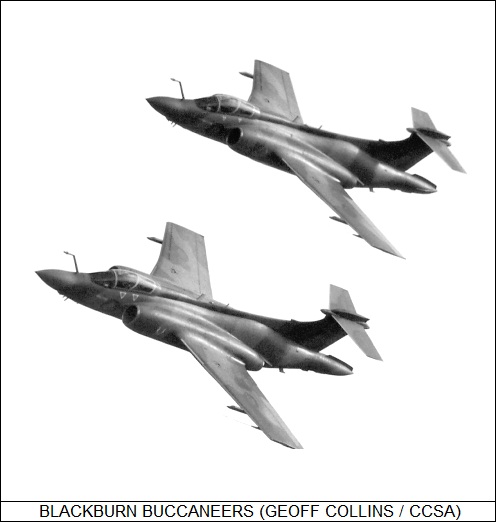
* I originally found out about Shorts PD.13 naval strike fighter concept in 2005 from a 1998 online article written by Robert Craig Johnson. The PD.13 was so comic-book bizarre that I first thought it was one of these fantasy machines modelers like to toy with on occasion -- but to my surprise, I found it was a real design, if never a real aircraft.
Every nation has come up with a few strange and amusing aircraft, but the PD.13 was appealingly strange in a way that seemed distinctly British, with its 1950s science-fiction story lines, teardrop fairings, and Canberra / Sea Vixen style offset canopy. It might be debated that the PD.13 was elegant, but nobody could claim it wasn't an attention-getter!
Johnson put together some drawings of what the PD.13 might have been if it had stolen the competition from the Buccaneer. One image showed a PD.13 kitted up for the Gulf War with overall desert pink colors, a nose refueling probe like the Buccaneer's, two AIM-9L Sidewinders, and two laser-guided bombs.
* Sources for this document include:
* Revision history:
v1.0 / 01 jun 99 v1.0.1 / 01 feb 02 / Review & polish. v1.1.0 / 01 feb 04 / Considerable technical enhancement. v1.2.0 / 01 feb 06 / Added "loser" variants. v1.2.1 / 01 jan 08 / Review & polish. v1.2.2 / 01 dec 09 / Review & polish. v1.2.3 / 01 oct 11 / Review & polish. v1.2.4 / 01 sep 13 / Review & polish. v1.2.5 / 01 aug 15 / Review & polish. v1.2.6 / 01 jul 17 / Review & polish. v1.2.7 / 01 jun 19 / Review & polish. v1.2.8 / 01 apr 21 / Review & polish. v1.2.9 / 01 feb 23 / Review & polish. v1.3.0 / 01 jan 25 / Review & polish. (+)BACK_TO_TOP
